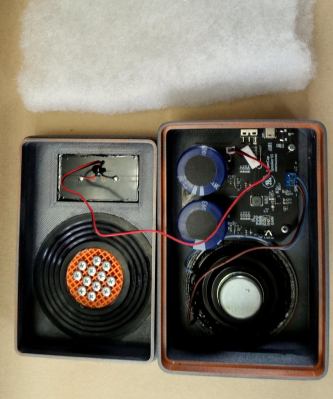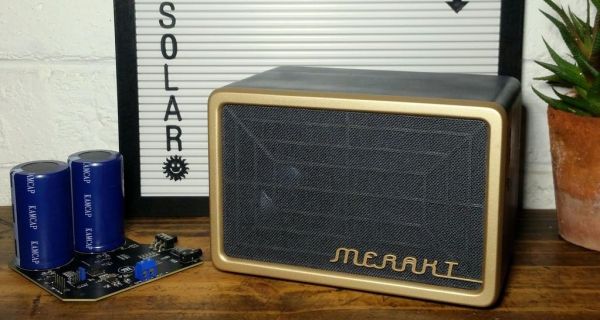Remember Dieselgate, the scandal where certain diesel vehicles would detect an emissions test, and run cleaner for it, “cheating” the test? Traingate may just put that one into perspective. We’ll tell the story from the beginning, but buckle up for a wild and astonishing ride. It all starts with Polish trains getting a maintenance overhaul. These trains were built by Newag, who bid on the maintenance contract, but the contract was won by another company, SPS. This sort of overhaul involves breaking each train into its components, inspecting, lubricating, etc, and putting it all back together again. The first train went through this process, was fully reassembled, and then refused to move. After exhausting all of the conventional troubleshooting measures, SPS brought in the hackers.
Continue reading “This Week In Security: Traingate, DNS, And JMP Slides”
Building A Solar-Powered, Supercapacitor-Based Speaker
Inspired by many months of hours-long load shedding in South Africa, [JGJMatt] decided to make a portable speaker that can play tunes for hours on a single charge and even charge off the integrated solar panel to top the charge off. None of this should sound too surprising, but what differentiates this speaker is the use of two beefy 400 F, 2.7 V supercapacitors in series rather than a lithium-ion battery on the custom PCB with the Ti TPA2013D1 Class-D mono amplifier.

The reason for supercapacitors is two-fold. The first is that their lifespan is much longer than that of Li-ion batteries, the second that they can charge much faster. The disadvantages of supercapacitors come in the form of their lower energy density and linear discharge voltage. For the latter issue the TPA2301D1 amplifier has a built-in boost converter for an input range from 1.8 – 5.5 V, and despite the lower energy density a solid 6 hours of playback are claimed.
Beyond the exquisitely finished 3D printed PETG shell and TPU-based passive bass radiator, the functionality consists out of a single full-range speaker and an analog audio input (TRS jack and USB-C). To add Bluetooth support [JGJMatt] created a module consisting out of a Bluetooth module that connects to the USB-C port for both power and analog audio input.
Charging the speaker can be done via the USB-C port, as well as via the solar panel. This means that you can plug its USB-C port into e.g. a laptop’s USB-C port and (hopefully) charge it and play back music at the same time.
For those feeling like replicating this feat, the Gerbers, bill of materials, enclosure STLs, and everything else needed can be be found in the tutorial.
Continue reading “Building A Solar-Powered, Supercapacitor-Based Speaker”
It’s A Microphone And A Spring Reverb All In One
We’re so used to reverb effects being simply another software plugin that it’s easy to forget the electromechanical roots of the effect. Decades ago, a reverb would have been a metal spring fed at one end with a speaker and attached at the other to a microphone. You may not see them often in the 2020s, which is probably why [Ham-made] has produced one. It’s not the type with a speaker providing the sound, though. Instead, this is a microphone in its own right with a built-in spring line.
Perhaps it’s not the best microphone possible, with a somewhat heavy diaphragm and 3D printed body. But the hand-wound spring transmits the sound down to a piezo disk which serves as the electrical element, and the whole thing screws together into quite the usable unit. There are a selection of sample MP3 files that provide an interesting set of effect-laden sounds, so if you fancy building one yourself, you can judge the results.
We think this may be the first reverb microphone we’ve seen, but we’re certainly no stranger to reverb projects. More common by far, though, are plate reverbs, in which the physical element in the system is a metal plate rather than a spring. We like it when the sound source is a Commodore 64.
Laser Cut Zither Instrument Kicks It Old World Style
Learning to play an instrument takes a certain level of dedication — and you can add another layer of dedication on top of that when it’s an instrument not found at your local Guitar Center. But it’s an entirely new level of dedication when someone crafts the instrument from scratch. If you’re looking for an example, check out this custom wooden zither [Nicolas Bras] built from laser cut parts.
The basic design of the instrument utilizes the sloted interlocking edges that are then glued together in lieu of traditional fasteners. Standard sized guitar tuning pegs and the accompanying steel guitar strings were then strung across two laser-cut bridges held in place by the string tension alone. The project began as way for [Nicolas] to learn the capabilities of his newly acquired laser cutter, but he himself is no amateur when it comes to constructing one-of-a-kind musical instruments. Just last year, he created a zither with bungee cords from the hardware store.
Zithers are German in origin, though some of the earliest zither-like instruments date back to 400 BCE China. The laser cut version [Nicolas] created had five strings to hammer on, though the type used in classical music arrangements typically contain upwards of thirty strings. The zither family of instruments may have given way to the electric guitars of today — it’s always neat to see new tech leveraged to embrace some old world charm.
For more on the art of DIY music production, check out this post on myriad of DIY musical instrument builds all played in concert.
Continue reading “Laser Cut Zither Instrument Kicks It Old World Style”
Charging While Driving Now Possible In Michigan
Heavy vehicles like semi trucks pose a bigger challenge in electrifying the transportation fleet than smaller, more aerodynamic passenger cars. Michigan now has the first public in-road charging system in the United States to help alleviate this concern. [via Electrek]
Electreon, a company already active in Europe, won the contract to provide for the inductive coil-based charging system at the new Michigan Central Station research campus. Initial runs will be with a Ford E-Transit for testing, but there are plans to actually allow public use along the one mile (1.6 km) route in the near future.
Vehicles using the system need a special receiver, so we hope we’ll be seeing an open standard develop instead of having to have a different receiver for each road you drive on. This seems like it would be a more onerous swap than having to have three different toll road transponders. Unfortunately, the page about wireless standards on the Electreon website currently 404s, but CharIN, the standards body behind the Combined Charging Standard (CCS) did just launch a task force for wireless power delivery in September.
If you’re curious about other efforts at on-road charging, check out this slot car system in Sweden or another using pantographs.
Sneakernet Power Transmission
Power outages in the face of natural disasters or more mundane grid failures can range from a mild inconvenience to a matter of life or death if you depend on electrical medical equipment. [Shareable] and [People Power Battery Collective] have partnered to develop a toolkit for communities looking to share power with each other in these situations.
Battery backup power isn’t exactly a new concept, so the real meat of this guide is how to build a network in your community so these relatively simple devices can be deployed effectively in the event of an emergency. We know that you can already handle your own backup power needs, but it pays to be a good neighbor, especially when those neighbors are deciding what to do when you’re releasing the factory-sealed smoke from your latest build on the community sidewalk.
For those who aren’t as technically-inclined as you, dear reader, there is also a handy Battery Basics (PDF) guide to help in selecting a battery backup solution. It is somewhat simplified, but it covers what most people would need to know. A note on fire safety regarding Li-ion batteries would probably be warranted in the Battery Basics document to balance the information on the risks of topping up lead-acid cells, but it otherwise seems pretty solid.
If you’re not quite ready to bug your neighbors, how about you build a backup battery first? How about repurposing an e-bike battery or this backup power solution for keeping a gas water heater working during a power outage?
Quick Negative Voltage For An Op Amp
It is a classic problem when designing with op amps: you need the output to go to zero, but — for most op amps — you can’t quite get down to the supply rail. If your power options are a positive voltage and ground, you can’t get down to zero without a special kind of op amp which might not meet your needs. The best thing to do is provide a negative supply to the chip. Don’t have one? [Peter Demchenko] can help. He uses a simple two-transistor multivibrator along with some diodes and capacitors to generate a minimal negative voltage for this purpose.
The circuit is simple and only produces a small negative voltage. He mentions that into a 910 ohm load, he sees about -0.3V. Not much, but enough to get that op amp down to zero with a reasonable load. Unlike other circuits he’s used in the past, this one is efficient. With a 5-volt input, it draws less than 1.5 mA.


















